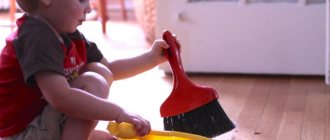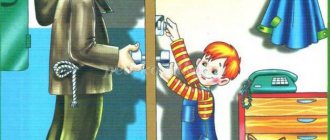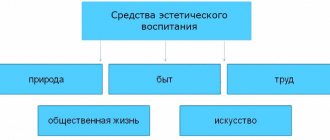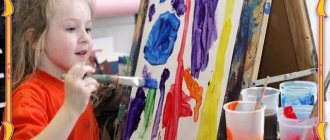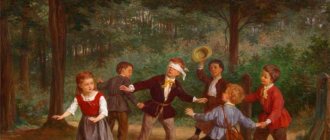The goals and objectives of labor education are of great importance for society. Have you ever asked yourself if humanity could survive without difficulty? The answer will be unequivocal, and even a slightly older kindergarten child will be able to justify it. Without work, progress is impossible, there is no movement forward. No development. Therefore, asking yourself the question: “do children need labor education,” the answer will come by itself - do your children need a progressive and successful future? Does our society need evolution and technological breakthroughs?
The goals that labor education sets for itself are global . No, if we are talking about a certain child, then everything is according to science: the development of personality, moral qualities, self-confidence, as well as work skills. But if the object of education is taken to be the younger generation as a whole, then the goals will be a healthy nation, a strong economy, technological progress and scientific discoveries. The problems are global, and their solutions are right in the palm of your hand - we need to teach children to work.
A few words about labor education
“You can’t even pull a fish out of a pond without effort” is taught in kindergarten. Not because this proverb is part of folklore, but because it really is so. Labor activity underlies a person’s entire life, from the moment of birth to the last breath. Giving a child knowledge and not teaching him how to work is the same as giving a car and not teaching him to drive. But we want the best for our children, right? Do we want our children to confidently manage their lives, cope with difficulties and solve complex problems? Then we place labor education in the “red corner”.
How do we understand education through labor? What is this? Pedagogy defines this process as the involvement of children in various work activities, organized and systematic. By engaging in work that is useful to society, children learn the experience of production work, labor skills and abilities. In addition, they develop creative thinking, hard work and patience.
Education of preschool children through work
Kharachoeva Natalya
Education of preschool children through work
Report on the topic for self-education “ Education of preschool children through work ”
Labor education is one of the most important aspects of raising the younger generation. In kindergarten, labor education consists of familiarizing children with the work of adults , introducing children to the work activities . In the process of becoming familiar with the work of adults, children develop a positive attitude towards their work , a caring attitude towards its results, and a desire to provide all possible assistance to adults. Labor activity helps to increase the overall development of children, expand their interests, demonstrate the simplest forms of cooperation , and develop such moral qualities as hard work , independence, responsibility for assigned work, a sense of duty, etc. In the process of work the physical strength and mental activity of children .
The labor education of the younger generation is one of the most important tasks of our society. The origins of labor education lie in preschool age , when the child first begins to feel the need for independent activity , declaring his intentions and showing himself to be the subject of his desires and interests. Fostering this need is one of the central tasks of children’s labor education .
A number of indicators of hard work :
— awareness of the purpose of the activity and persistence in achieving it;
- willingness to complete the work started;
manifestation of an emotionally positive attitude towards work ;
— adequate assessment of performance ;
— accuracy, diligence, careful attitude to the means and products of labor are most successfully formed in preschool and primary school age. Their lack of formation at this age stage becomes an obstacle to educational and cognitive activity and subsequent adaptation to independent work .
In preschool pedagogy, three ways of bringing children closer to the work of adults : observation of work , partial assistance of children to adults, and organization of joint activities of adults and children .
A.V. Zaporozhets wrote: “The central link of this entire system (meaning the system of comprehensive education of preschoolers , as if tying into a single unit all the educational work of the kindergarten, should be the moral and labor education of preschoolers , which is intended to be laid already in the first years of a child’s life are the basis for an active life position, understanding of one’s responsibilities and readiness to fulfill these responsibilities.”
V. A. Sukhomlinsky drew attention to the other side of the educational influence of work of work ! This joy comes from success, awareness of his skill and the significance of the work he does, and the opportunity to bring joy to others.” with peers in , preschoolers gain experience in relationships, learn to see the emotional state of a peer, his sorrows and joy. All this encourages the provision of help, support, and the manifestation of humane feelings: empathy, sympathy.
But such opportunities can be realized only if certain conditions are met: the teacher creates an emotional atmosphere when organizing children’s work , demonstrates to them their interest in the upcoming activity , participates in it as a partner, and encourages children’s desire to participate in joint activities . At the same time, the main goal of the teacher is to cultivate in preschoolers a positive attitude towards work , to develop the desire to learn, to become independent, skillful, able to cope with emerging difficulties and provide help and support to others if necessary. Along with the achievements in the labor education of children in preschool institutions, there are still many problems and unresolved issues. Not all preschool institutions provide interaction between an adult and a child at the level of co-creation, assistance in play, work and cognitive activities . There are difficulties in selecting objects of labor activity , the scope of work of preschool children . Neither educators , teachers, nor parents a sufficiently complete understanding of the essence Labor education of preschool children has not yet become a leading direction in the educational process of preschool educational institutions.
Often, teachers in older groups , when organizing the joint work activities of children , do most of the work themselves. And the children are left with only individual tasks - bring, serve, help, hold, which, naturally, does not arouse their interest in the work process . There is also another extreme in practice, when educators give inflated work assignments without taking into account the children’s capabilities. Children also get tired when they spend a long time doing one thing, stay in one position, use equipment that does not correspond to their age capabilities, and perform a large amount of work at a fast pace. Unfortunately, you can often observe how a nanny or teacher in front of children redoes what they have done: washes the table, sweeps the floor, puts away books, rearranges chairs, etc.
And finally, an important condition in labor education is knowledge of the characteristics of family education . There are also objective problems that make it difficult to instill hard work in preschoolers : the economic crisis, increasing the breakdown of the family, satiety with amenities, the outflow of children from preschool institutions ; decreased attention to the formation of hard work (in comparison with the physical, mental, aesthetic development of the individual)
from parents and
educators ; the desire of preschoolers for self-actualization in the children's community with little social experience.
The program tasks of labor education of preschool children can be combined into several groups.
The first group includes the tasks of cultivating a positive attitude towards the work of adults , the desire to provide them with all possible assistance, and an interest in the results of work . At the same time, children form ideas about the need for work in life , about the attitude of adults to work .
The second group consists of tasks aimed at developing work skills and their further improvement, gradually expanding the content of work activity , as well as mastering the ability to work accurately, deftly, and at a fairly fast pace.
The third group of tasks is aimed at nurturing certain personal qualities in children: habits of work effort , responsibility, caring, thrift, readiness to take part in work .
The fourth group consists of the tasks of developing skills in organizing one’s own and general work - the ability to prepare everything necessary in advance, put away tools.
The fifth group includes the tasks of forming positive relationships between children in the labor - the ability to work in harmony.
It should be borne in mind that all planned tasks are not carried out in isolation from each other, but in close interconnection. A set of these tasks in the pedagogical process are carried out simultaneously. The work of a child differs from the work of adults . The child does not create socially significant material values work The point is not that work has no result, that what he does is of no use to anyone. The work of preschool children has social significance. In ancient times, when childhood was shorter and the child was earlier involved in the activities of adults , his work was also socially significant. However, a modern child, especially a child of preschool age , cannot be involved in production and, therefore, cannot create material values.
The work of children is educational in nature - this is how adults look at it. Work satisfies the child’s need for self-affirmation, for knowledge of his own capabilities, brings him closer to adults - this is how the child himself perceives this activity (of course, without putting this perception into scientific terms )
.
In the work of a preschooler, a connection with play is clearly revealed. labor in nature : they contain imaginary labor operations . But not only this exhausts the meaning of the game, in which the child, in role-playing actions, reflects the work of adults . Taking on the role of an adult, he becomes imbued with an emotional attitude towards the actions being performed: he worries about the patient, pays attention to passengers, etc. He experiences emotional uplift, excitement, joy, his feelings correspond to the feelings of a worker, although they are not associated with labor efforts .
When performing a work task , children often switch to play - they play with water while washing, play out , etc. d.
According to its content, the work of preschool children is divided into four types. Labor of preschool children
Self-service
Household labor
Labor in nature
Handmade and artistic work
Self-care is the work of a child aimed at serving himself (dressing and undressing, eating, sanitary and hygienic procedures)
.
The quality and awareness of actions is different for different children, so the task of developing self-service skills is relevant at all age stages of preschool childhood . The content of work changes at different age stages and as children master work skills . If a child has mastered the ability to dress independently, he needs to be taught to do it neatly, beautifully, quickly, and to take care of his appearance and hairstyle. Children are taught the habit of taking care of things, not getting dirty, not tearing clothes, and folding them carefully. The content of work for older preschoolers also includes self-care: - preparing the workplace before starting drawing; - cleaning and even washing (at home)
cups, spoons after meals, making the bed, tidying up toys and books.
Having learned self-service, a child acquires a certain independence from an adult and develops a sense of self-confidence. Of course, even in older preschool age, children sometimes need the help of an adult, but still, before entering school, they should already be able to do a lot on their own.
Household work is the second type of labor that a child of preschool age is able to master. The contents of this type of labor are : - labor for cleaning the premises ; - washing dishes, laundry, etc. If labor is initially intended for life support, for taking care of oneself, then household labor has a social orientation. The child learns to create and maintain his environment in an appropriate manner. his household skills both in self-care and in work for the common benefit . Positive assessment and praise are very important. Children of middle and senior preschool age are capable of more varied household work and need less help from an adult. They can do: - cleaning a group room (wipe dust, wash toys, arrange light furniture)
;
- cleaning the area (raking snow, removing leaves)
;
- take part in food preparation (salads, vinaigrette, dough products)
;
- in the work of repairing books , toys, clothes. Gradually, children acquire independence in this type of work . The teacher uses methods of showing, explaining, discussing the work process and results , evaluating, teaching certain ways to perform labor operations (how to wring out a rag so that water does not flow down the sleeves, etc.)
.
It is important to form in preschoolers an idea of the importance of household work for everyone and for everyone personally. It is this work that makes it possible to show the child that he himself can make the environment in which he lives beautiful and pleasant. The teacher always draws the children's attention to this side.
If each of us cares about making everything around us beautiful, we will not be able to throw a piece of paper on the floor and, of course, will not draw on the wall or in the elevator. Only someone who doesn't love his home can do this. Labor in nature . The content of such work is caring for plants and animals, growing vegetables in the garden, landscaping the area, participating in cleaning the aquarium, etc. Labor in nature has a beneficial effect not only on the development of labor skills , but also on the education of moral feelings , and lays the foundations of environmental education. In younger groups, children's attention is drawn to plants and animals. The teacher organizes observations of animals and at the same time tries to maintain the interest of the kids. Together with an adult and under his guidance, the child cares for living objects. The responsibilities of children of senior preschool age are much broader. And this is understandable. The child already knows more, knows more.
Labor in nature has its own characteristics. The result of this work can be a material product (vegetables grown by a child, a tree planted by him, etc.)
.
This brings child labor closer to the productive labor of adults . Labor in nature most often has a delayed result: they sowed seeds and only after some time were able to observe the result in the form of seedlings, and then fruits. This feature helps to cultivate endurance and patience.
While caring for animals and growing plants, the child always deals with living objects. Therefore, special caution, careful attitude, and responsibility are needed. The absence of these factors can lead to the death of a living person. Working in nature makes it possible to simultaneously develop cognitive interests. Children observe the growth and development of living objects, learn about the characteristics of some plants and animals, experiment, learning about inanimate nature. This type of work gives children the opportunity to bring joy to other people (treat them with grown fruits, give flowers)
.
Thus, work in nature contributes not only to labor education , but also to moral, aesthetic, mental, and physical development.
Manual and artistic labor - by its purpose, is labor aimed at satisfying the aesthetic needs of a person. Its content includes the production of crafts from natural materials, paper, cardboard, fabric, wood. This work contributes to the development of imagination and creative abilities; develops small arm muscles, promotes endurance , perseverance, and the ability to finish what you start. with the results of their work by creating gifts for them. Artistic work in a preschool institution is presented in two directions: children make crafts and learn to decorate the group room for holidays with their products, design exhibitions, etc. Certain elements of manual and artistic labor can be introduced already in younger groups. In this case, the participation of an adult is mandatory. More precisely, children help an adult in creating crafts. And although the activity of children of this age is minimal, involvement in such interesting work is very useful . The child sees how, in the hands of the teacher, a simple stick suddenly turns into a doll, and a ball into the head of a funny clown. This is magic"
fascinates children, delights them and motivates them to
their own activities . In relation to preschool age, we can also talk about the emergence of mental work .
Any work is characterized by an effort aimed at achieving a result. The result can be: - materialized (an object made by a child, a plant grown)
;
- can be represented through quality improvement (washed doll linen, cleaned bird cage)
;
- can also act as a logical solution to some problem (mathematical, everyday, the child’s own “discovery”
obtained as a result of thinking, etc.).
Labor education of children in a preschool institution should not be carried out in isolation from family education . hard work in children . This is, first of all, visibility, accessibility of a variety of household work performed daily by adults in front of the child, the tangible results of this work , the opportunity for the child to systematically participate in this work , work together with adults. working together with older family members, , imitating his elders, quickly masters work skills and adopts rational work methods. Working together with parents brings joy to the child. Participation in household work allows the child to really feel his involvement in the concerns of the family, to feel like a member of the family team. This helps to develop many important personality traits: responsiveness, caring, thrift, responsibility.
To promote among parents the content and methods of labor education of preschoolers, various forms can be used: meetings, consultations, conversations, lectures, open days, thematic stands, exhibitions, etc. A visual familiarization of parents with the organization of labor education in kindergarten gives .
Many parents of younger preschoolers tend to underestimate their capabilities. The teacher’s task is to convince parents of the need for timely introduction of children to work , education of independence , to reveal the role of the child’s age-related characteristics favorable for this (activity, imitation, receptivity to the demands of adults, content and methods of labor education of younger preschoolers in kindergarten and in the family.
Labor education is a joint activity of the teacher and pupils , aimed at developing general labor skills and abilities, psychological readiness for work , the formation of a responsible attitude towards work and its products , and a conscious choice of profession.
Analysis of pedagogical experience allows us to assert that the work of preschool children is the most important means of education . The entire process of raising children in kindergarten can and should be organized so that they learn to understand the benefits and necessity of work for themselves and for the team. Treating work with love and seeing joy in it is a necessary condition for the manifestation of a person’s creativity and talents.
Main tasks of labor education
In the process of labor, not only material objects are created, but also the person himself is improved. Therefore, the goal of labor education, first of all, is to educate a harmonious personality, and then to form his psychological and physical readiness for work.
Against the backdrop of social and economic development, reality places high demands when it comes to the identity of the producer. The importance of his attitude to work as a conscious need, as well as a vital need, a positive attitude towards work, respect for work (in general), and for its result is emphasized. Sociability, initiative, creativity – these are the qualities that the working world expects from a mature personality. And these qualities are formed in the process of labor education.
Readiness for work is the result of labor educational activities, which, in turn, solves the following problems:
- Formation of skills and abilities in work;
- Awareness of the goals and objectives of work;
- Formation of automotivation for work.
Goals and objectives of labor education of preschool children
Considering that the economic, environmental and social situations in the country are changing dramatically, the direction and meaning of labor education is changing. New techniques, motivations and approaches are required.
Introduction to adult labor
Familiarization with the varied work of others can significantly expand a little person’s understanding of the activities of other people, provide initial knowledge about its significance and importance, and also form a positive attitude towards it.
Acquaintance with adult labor includes stories about the creation of labor products, acquaintance with a hard worker and different professions. It forms an initial understanding of the content of the child’s future activities and fosters general respect for work.
Problems of labor education in preschool educational institutions and schools
Getting to know a working person is the main direction of application of this means of education, against the background of which familiarization with the labor process acquires secondary importance, it becomes content that reveals the characteristics of a person’s activity sphere.
Familiarization with difficulty gives knowledge about the composition, the order of actions, children find out that dividing and performing actions speeds up obtaining a result and greatly improves its quality. Children quickly begin to understand that if everyone knows how to do their job well, the result becomes much better .
Goals of labor education
?
Education through labor is an indispensable condition for the comprehensive, full development of the individual. On the one hand, physical labor stimulates mental activity, and on the other, the moral qualities of the individual.
In pedagogy, the main goal of labor education is the moral and psychological (practical) preparation of children for work. The goal is achieved gradually, taking into account the age, capabilities, and interest of the children. The global goal is a hardworking society, ready for change, capable of working for the benefit of their families and the common cause.
Labor education at school - the main tasks and their solution
Labor education begins in the family - we have talked about this more than once. But school also has a significant influence on the upbringing of a young person. For schoolchildren, work is a necessary and important means of developing moral ideas and personality traits. The goal of labor education of schoolchildren is the formation of a natural physiological and intellectual need for work. At school, it is closely connected with the polytechnic training of students, which ensures a level of knowledge of the basics of technology and organization of production.
Within the walls of a comprehensive school, labor education solves several basic and important tasks:
- Motivation to work, stimulation of interest in knowledge, the need for work as a creative process, the desire for practical activity;
- Formation of a positive attitude towards work among schoolchildren;
- Education of moral qualities: a sense of duty, hard work, responsibility, mutual assistance, determination, perseverance, honesty;
- Development of students' creative abilities through manual labor;
- Schoolchildren mastering various types of techniques, labor skills, forming an internal culture of physical and mental work.
Tasks of labor education of preschool children
Labor education of preschool children begins in the family and is of great importance for the development of a little person. Preschool age is a period of imitation. Children copy everything they see. They like to work. This unique moment cannot be missed. It is necessary to encourage initiative, stimulate interest, and develop the work skills of children.
According to the Federal State Educational Standard, the term “labor education” is a system for developing in children diligence, labor skills and the desire to learn to work.
Teachers see the goal of labor education in kindergarten as the formation of the same positive attitude towards work and moral qualities. Instilling respect for the work of adults is one of its main goals.
In the work activities of preschoolers, an important role is assigned to the teacher. The teacher’s task is to help the child acquire his own experience and skills in work that is feasible for his age. Involvement in work activity allows them to demonstrate their abilities, feel like a part of the adult world, and enjoy the joy of contemplating the result of their work. The teacher organizes work activities, unites the team, teaches children to work together, help adults, and each other.
MAGAZINE Preschooler.RF
Labor activity as an important means of education in preschool ageAnnotation. The article provides definitions of the terms “labor” , labor activity”, examines the main types of labor in which a preschooler is involved, and characterizes the influence of labor activity on the comprehensive development of the personality of preschool children.
Key words: labor, labor activity, labor education, preschoolers, preschool age.
The main goal of the implementation of the Federal State Educational Standard for Preschool Education is the formation of a general culture of students, the development of their moral, intellectual, physical, aesthetic qualities, initiative, independence and responsibility. Solving the problems of children's development should be aimed, among other tasks, at gaining experience in elementary work activities (self-service, household work, work in nature).
The end of the 20th - beginning of the 21st century is a stage in preschool education, which was distinguished by the oblivion of the problem of introducing a child to work. In many publications of preschool education programs, implemented before the release of the Federal State Educational Standard for Preschool Education, listing the requirements for the structure of the main general education program of preschool education, labor education was not allocated to a special section. Currently, the section “Labor education” is presented in preschool education programs as an integral part of the educational field “Social and communicative development” .
Labor activity is “the process of actively changing objects of nature, the material and spiritual life of society in order to satisfy human needs and create various values. The subject of the psychological study of labor activity is the mental processes, factors, states that encourage, program and regulate a person’s labor activity, as well as his personal properties” [4, p. 117].
Labor activity, according to S.A. Kozlova, is a concept that summarizes different types of labor, consisting of labor processes (for example, dressing, undressing, washing hands, setting the table, wiping dust from furniture, etc.). The labor process is a unit of labor activity. Its structure presents all components: the purpose of labor, material and labor equipment (tools); a set of human labor actions to transform materials using tools; the achieved result of labor that satisfies human needs [2, p. 173].
Labor, according to Ya.P. Kolominsky, is “a complex activity, the implementation of which requires a certain level of physical and mental development. Preparing a child for future work begins long before he can take part in socially useful work. The mental qualities of a person necessary for work are formed under the influence of living conditions and upbringing” [3, p. 134].
The formation of elementary labor activity in preschool childhood occurs in the process of interaction with an adult.
Preschool children are characterized by subject activity, which should be considered as a prerequisite for labor activity. At this age, child labor most often finds its way into play. Imitating the work actions of adults is the main content of children's play, allowing them to master these actions and thereby contributing to the development of work activity. However, she is very unstable at first and goes back into play.
Labor processes gradually develop into types of labor. “The first time a child masters self-service, the characteristic feature of which is focus on oneself, and the content is the ability to serve oneself (dressing, undressing, eating, hygiene procedures). Household work presupposes the ability to maintain order in the environment of a kindergarten group, on a site, at home (setting the table, preparing the necessary material for making crafts, etc.)” [ 1, p. 269]. “Labor in nature is distinguished as a special type of labor. The content of such work is caring for plants and animals, growing vegetables in the garden, landscaping the site, participating in cleaning the aquarium, etc. Labor in nature has a beneficial effect not only on the development of labor skills, but also on the education of moral feelings, laying the foundations of environmental education
Manual and artistic labor, by its purpose, is labor aimed at satisfying the aesthetic needs of a person. Its content includes the production of crafts from natural materials, paper, cardboard, fabric, wood. This work contributes to the development of imagination and creative abilities; develops small arm muscles, helps develop endurance, perseverance, and the ability to finish what you start” [2, p. 173].
At preschool age, children gain an understanding of the role of work in human life and society, become acquainted with the work and professional activities of adults, the world of professions, are included in feasible work activities in kindergarten and family, acquire initial labor skills and work experience, learn to plan, apply efforts, to bring the work started to completion, to interact with partners, to provide assistance, to appreciate the results of one’s own and others’ work.
It is also necessary to develop labor activity itself - from individual labor processes to the simplest types of labor. The solution to this problem determines the child’s inclusion in work, his ability to take part in joint activities, and achieve a common result with adults and peers. It is necessary to introduce preschoolers to the work of adults, to cultivate interest and a positive attitude towards it, hard work, independence, perseverance, responsibility, and friendly relationships with peers in the process of activity.
Bibliography
- Preschool pedagogy with the basics of methods of education and training: Textbook for universities. Third generation standard / Ed. A.G. Gogoberidze, O.V. Solntseva. – St. Petersburg: Peter, 2013. – 464 p.
- Kozlova S.A., Kulikova T.A. Preschool pedagogy: textbook. aid for students avg. ped. textbook establishments / S.A. Kozlova, T.A. Kulikova. – M.: Academy, 2000. – 416 p.
- Kolominsky Ya.P. and others. Mental development of children in normal and pathological conditions: psychological diagnostics, prevention and correction / Ya.P. Kolominsky, E.A. Panko, S.A. Igumnov. – St. Petersburg: Peter, 2004. – 480 p.
- Psychology: Textbook for humanitarian universities / Ed. ed. V. N. Druzhinina. – 2nd ed. – St. Petersburg: Peter, 2009. – 656 p.
| Next > |
